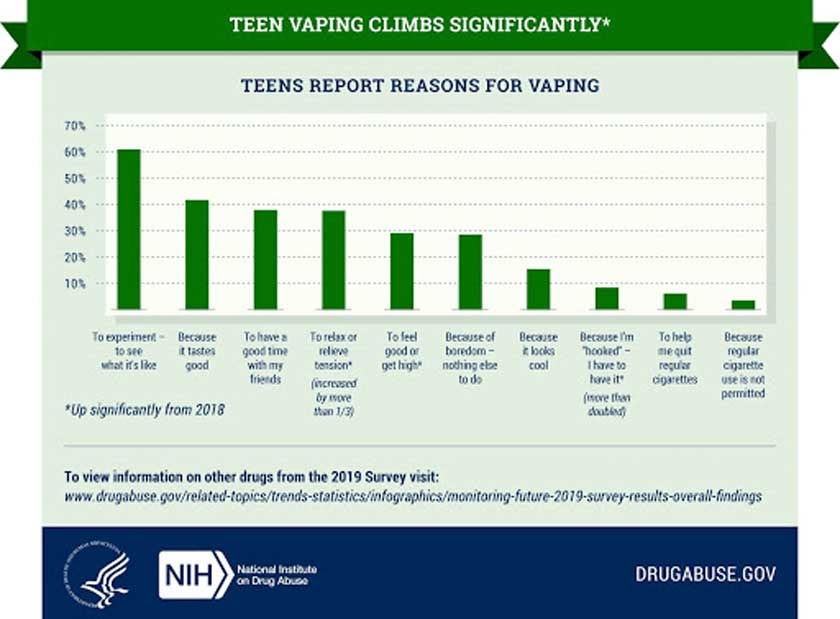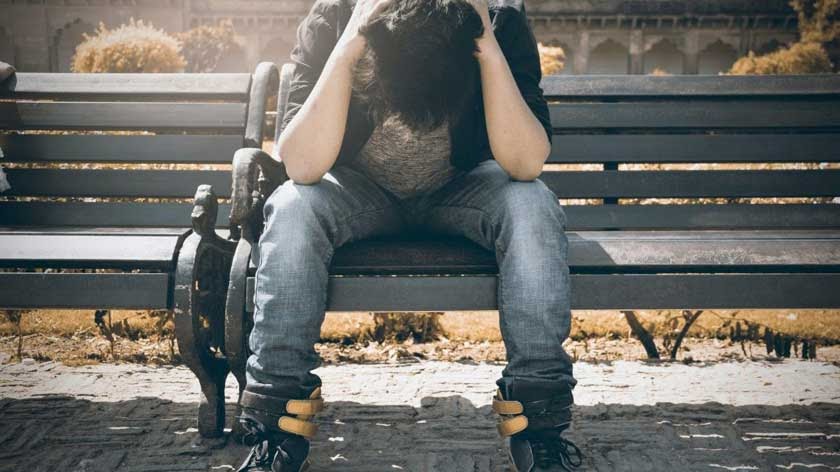By the Numbers: National Survey Captures Teen Drug Use
What’s My Kid Thinking by Vaping?
It’s great when parents want to think from the perspective of their child. This helps grow understanding, communication, and can help a parent learn more about particular topics.
Online Education Helpful
One method is by visiting reddit.com. This is an online community forum people join to make comments and ask questions on everyday topics, such as discussing the final episode of a television series or more serious topics, such as drug use and vaping.
A recent glimpse from an older posting shows one commenter calling their school bathroom a “hot box” for drug use and vaping, even claiming in a partial joke that it is like a student cartel. Schools do address the issue, as several noted, but there is widespread disparity about who listens, and some schools are nowhere near the level of use as another school.

Open Communication About Teen Alcohol and Drug Addiction
What does your teen think about vaping? Have you asked them about it? Beginning a discussion at a young age and continuing this approach, as well as modeling good behaviors, are methods that counselors highly recommend for parents.
If the conversation begins later in their teens, it is still helpful to begin. Your child might be amazed at your willingness to listen. One parent who did this said their teen bragged to other friends that she was happy she could talk with her parents, even encouraging them to open up to theirs.
The teen discussed high school parties, choosing to stay away if parents aren’t home. During the pandemic, she has shown an even lower tolerance to risk-takers, which others might brush off as typical teen behavior. She even called into her school’s anonymous hotline with a tip about several friends who attended a weekend party, sharing drinks, and the teens were then quarantined at home as a precaution. She felt protected by the anonymity and said her friends told her they learned a lesson, without even knowing she was the initiator of said lesson!
This same teen had been found drinking in her bedroom just two years prior and vaping nicotine and marijuana. She opened up about her addiction to her parents and said she was no longer using but was amazed how long her withdrawal cravings lasted. This family has come full circle in these few years.
National Numbers Show Teen Vaping Addiction Rising, Drug Use Dropping
Is your family struggling because you suspect your son or daughter has been drinking alcohol or involved in drug use? “How could this happen?” you might wonder.
There are many different ways each household operates:
- Do you “run a tight ship” kind of house where curfew is a specific time and not one minute later, and everyone knows you will smell their breath or give them monthly urine tests to check for marijuana?
- Is your struggle more related to keeping food on the table in a one-parent home, and your oldest child helps get the younger one to school and is more your roommate than your child?
- Maybe your daughter or son is the youngest or only child and you generally operate as a tight unit.
Would you be surprised to learn that teens in each of these homes have been drinking alcohol or taking drugs? Do you think one is more likely than another? Perhaps that is true, but does it really matter? You really can’t control your child’s every move. They need to learn how to make decisions based on guidance and  education because one day they won’t be in your home anymore.
education because one day they won’t be in your home anymore.
So how can you help them—not control them—along the way?
Counseling Goes Far To Teach Teens About Drug/Alcohol Use
Learning how to identify problems and how to work on them are key issues behind Bricolage Behavioral Health and other treatment centers and are based on the Seven Challenges Program. The Substance Abuse and Mental Health Services Administration (SAMHSA) considers this as an example of effective evidence-based counseling.
Mental health and other problems are generally among the roots that need to be identified and alcohol and drug use are symptoms—and unhelpful coping skills for the other issues. Relying on them can lead to addiction and be harmful to health.
This is not important just for teens but people as a whole and at all stages of their lives. It can be applied to situations such as not liking your job, someone’s behavior affecting your responses, or a traumatic event that may have occurred or will occur in the future.
Now that we understand a little more about an effective way to speak and work through substance use issues with teens, let’s look at some numbers both around the country and in Texas to better understand what our teens are experiencing.
Annual Survey Measures Drug, Alcohol, and Nicotine Use Among Eighth, Tenth, and Twelfth Graders
Since 1975, students have participated in the Monitoring the Future National Drug Use Survey by the National Institute on Drug Abuse (NIDA), part of the National Institutes of Health. Data collected from the last month, year, and over the students’ lifetimes has examined drug and alcohol use statistics and attitudes around them. In the 2019 survey administered by the University of Michigan, 396 schools both private and public participated with a total of 42,531 students. The 2020 survey will be released soon and surveyed about a quarter of the schools and students due to difficulties related to the pandemic.
In 2019, there was a general decline in prescription opioid misuse, tobacco cigarettes, and alcohol. What was increasing?
Teen Marijuana Vaping Nearly Doubles From One Year Earlier
Vaping is using a battery-powered device that is loaded with a removable cartridge. By inhaling, the person activates a heating element that then vaporizes the substance in the cartridge. The resulting vapor is then inhaled.
You might find these cartridges in your child’s backpack and wonder what they are. You can also see them scattered at bus stops and in area parks close to schools. Many of the products purchased in gas stations contain nicotine flavorings, which have been the main appeal to the teen taste buds.
Eighth graders, tenth graders, and twelfth graders reported that 0.8%, 3%, and 3.5% respectfully had vaped THC daily. For those who said they had vaped marijuana at some point in the month prior, the numbers were 3.9%, 12.6%, and 14%.
Nicotine Vaping
In the same order for grade level, 10%, 20%, and 25% had vaped nicotine monthly and daily use was 2%, 7%, and 12%. Vaping nicotine seems on the upward trend with cigarette smoking continuing to decline.
Number one reason listed for vaping? It’s summarized in five words, right there in the survey. To. See. What. It’s. Like.
The 2019 Monitoring the Future survey was the first time daily nicotine vaping had been tracked in the 45 years of the survey. It was also the second-largest one-year jump in any substance category for the 14% (up from 7.5% the year prior) of twelfth graders admitting monthly THC vaping. Nicotine holds the record, but they both have vaping as a common tool.

Teen Addiction No. 8 and 9 in Reasons To Vape
The NIH chart lists 10 reasons why teens say they have vaped, many of which an adult can empathize with as it is not unusual to try something new or revert to a behavior out of boredom. And as adults know all too well, choices have consequences. As human beings, this occurs throughout life.
Main Reason For Teen Vaping: Experimentation
Let’s examine this using a gallon of ice cream as a substitution on the “experiment” reason the students gave. This was the number one reason they listed for picking up a vape pen and using it. Those five words “to see what it’s like.”
You might know that trying a spoonful of a new flavor could be fun. If you like it, you serve up a proper portion size and enjoy after dinner so you can still eat your daily nutrition. How do you know not to eat the whole gallon all day long? How do you know that you should have exercise in some part of your routine? That comes from learning.
If you look at the fourth and fifth reasons, they deal more with mental health—anxiety and happiness. Exploring the other ways to achieve tension release and the body’s ability to normally produce happiness are situations that can be explored through therapy sessions in a treatment program we described earlier as the Seven Challenges program.
This survey offers invaluable data to help counseling approaches related to behavioral choices such as teen substance use. Recovery from reliance on substance use is the goal to ensure bright futures with all opportunities available to your daughter or son.
Substance Use Declining as Vaping Popularity Grows With Youth
Let’s look at some more data from the survey regarding alcohol, the most commonly used substance among teens. The percent of teens who self-reported consuming any alcohol during their lifetime (grades 8, 10, and 12) were 24.5%, 43.10%, and 58.5%).
Facts show more than one in four eighth-graders and one in two seniors will have consumed alcohol in some quantity. The good news is that binge-drinking, which is defined as drinking five or more drinks in a row, has declined from a high point in 2014 of 19.4% of twelfth graders to 14.4%.

Binge-drinking can create a flurry of problems for a teen using the resulting impaired judgment, such as:
- Accidents (emergency room visits for alcohol-related incidents nearly reached 200,000 in 2011)
- Death (car accidents, drownings, falls, burns, alcohol poisoning)
- Sexual/physical assaults
- Risky behavior (using another drug while drinking, unprotected sex, trouble with the law)
Alcohol and drugs in the teenage brain can affect a 15-year-old girl’s ability to process information, so she may have trouble recalling information needed for her chemistry test. A 17-year-old boy who used to find writing essays for English easy may discover he has difficulty remembering key elements from his reading and then struggles to use examples in his writing.
Both kids will also be putting themselves at risk for developing a substance use disorder (SUD) in the future by initiating alcohol into their brain development at such young ages. Drinking before age 15 has been shown to increase the likelihood of developing a SUD four times over.

Illicit Drugs and Prescription Medication Use Decline Among Teens
The survey shows 11.5% of twelfth graders admitted using an illicit substance in the past year, other than nicotine. What were they? From LSD, synthetic marijuana, cocaine, MDMA (Ecstasy or Molly), and heroin these numbers were, in order, 3.6%, 3.3%, 2.2%, 2.2%, and 0.4%.
Prescription medications like Adderall® were on a significant decline for being misused, with that number doubled for eighth-graders. Pain medications like Vicodin® and OxyContin® also declined.
That might be due to the recent crackdowns on prescription availability. This became glaringly public in November 2020, following the debacle created when pharmaceutical companies like Purdue Pharma admitted to incentivizing doctors to prescribe these drugs, and the ensuing opioid dependence crisis reached epic levels across the country.
Keeping an Eye on the Vaping Trend for Teens
Vaping can cause injury to the lungs, as evidenced by hospital deaths and lung conditions surfacing in the summer of 2019. Targeting marketing to youth has been a big influence and one that the vaporizer companies are being held to a higher standard. Worry that this could trend toward a reliance once again on tobacco cigarettes is also a concern.
According to Dr. Nora Volkow the director of NIDA, in her blog: “What became evident in 2018 was that vaping devices, which have exploded in popularity over the past several years, are now exposing a new generation to nicotine. Those trends continued in 2019, but with the additional concern of a rapid rise in the vaping of marijuana, as well as increases in daily marijuana use in 10th graders.”
With the 2020 numbers due at the end of the year and reflecting a lower population surveyed due to the pandemic, it will be interesting to see the data collected. Past indicators showed a rise in vaping, and the current results to cull data from are at a low. Somewhere in between will be the truth, perhaps.
Texas Teen Drug and Alcohol Use by the Numbers
Now that we’ve looked at national figures, let’s look at the Lone Star State statistics for alcohol and drug use.
In a one-month snapshot of underage alcohol consumption, 36,000 (3.2%) adolescents between 12-14 years old drank alcohol, followed by 194,000 (16%) teens ages 15-17 and 432,000 (37.1%) ages 18-20. These are 2017 numbers detailed in a 2018 Texas report by the Substance Abuse and Mental Health Services Administration (SAMHSA).
The report soberly points out the loss of 372 lives in underage alcohol-related accidents that represent 22,574 years of potential life lost. As we pointed out earlier, with alcohol and drug use risky behaviors become more likely. And a major impact can be measured in lives lost.
Interestingly, Texas has some laws for which other states have stricter requirements. For example, you can be an 18-year-old senior in high school and serve alcohol or bartend without a manager present. There are no requirements limiting a liquor retailer’s geographical distance from schools at primary or secondary levels. A gas station also cannot sue someone for using an illegal identification, yet can be held responsible if they do not require identification on alcohol purchases.
Substances ranking high for overdose calls to the emergency rooms in 2015 in Dallas County were, in order, benzodiazepines (17.6%), heroin (5%), marijuana (4.8%), and synthetic marijuana (3.9%).
Regarding Dallas youth, for every 10,000 juvenile groups, 10 were charged with drug possession and 0.9 with drug trafficking.

Health, Age Limit Information for Drug Rehab Treatment Among Young People
Drug treatment was tracked on a limited basis, but cannabis (247 youth) was the substance a youth was most frequently treated for, followed by opioids (30 youth). Tracking, masking, and privacy are reasons behind the difficulty in getting a bigger picture of the drug treatment path individuals have taken.
Teenagers do go to rehab and it can be very effective for young people to take a pause and consider their life trajectory. Learning helpful coping skills is a life skill that will prove invaluable at multiple levels during all the challenges yet to come their way. Treatment can show care, even if the young person is resistant to the idea at first.
Help, Prevention, Treatment, Rehab, and Recovery for Teens Possible
There is life after a teen’s early exposure to alcohol use and drugs. Steps can be taken to minimize their risks and to treat their stumbles. Keeping the alcohol, drug, and nicotine conversations open and honest in families is a major preventive step in a teen’s ability to open up with parents. This stops them from silently wanting help for anxiety or depression and feeling they can voice their mental concerns. If there is a SUD condition, counseling and the Seven Challenges offer many opportunities to help a teen gain control and build confidence for a healthier lifestyle and stronger choices for their future.
Bricolage Behavioral Health can help your child and family with evidence-based care and family integration throughout teen treatment. We offer partial hospitalization and intensive outpatient programs, in a supportive environment with academic considerations. Call 469-968-5700.
FAQs:
How Can Adolescent Drug Use Be Prevented?
Talking early and often with age-appropriate comments is a major component for families to use in preventing drug use. Modeling behavior is also important for adults in a teen’s life. Keeping a family routine, whether it’s a scheduled Sunday dinner or Thursday game night can be a good opportunity to check in with the whole family.
What Methods To Reduce Adolescent Drug Use Are Successful?
If your child is using drugs on a habitual level, it is often an indicator of another issue. Counseling with evidence-based therapy is very constructive in teaching a teen to problem-solve and discover their emotions and the reasons behind the use.
Providing a counselor skilled in this area, along with supporting motivational aspects of their life are two ways a parent can help their child. If your child enjoys animals, sports, or music, help them get lessons or volunteer to keep their mind occupied
What Causes Adolescent Drug Use?
There are many reasons, some simple and seemingly harmless, and others that show a deeper problem that needs to be addressed. It can be as simple as just wanting to try something, as teens move into the ages where testing limits is very common. But it has more consequences than a toddler reaching for a snack. Enjoying the taste of a substance, such as flavored nicotine or alcohol, ranks pretty high on their lists of reasons they have used. Boredom, anxiety, and depression are other specific reasons that teens have given for taking drugs. Situations that put them at risk include not having an active adult in their life or any consequences for behaviors.




